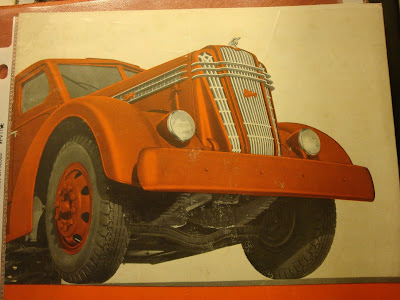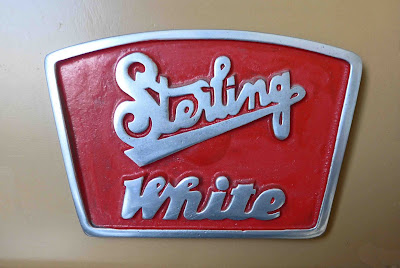Sterling Motor Truck Co. (1916-1933)
Sterling Motors Corp. (1934-1951)
Sterling-White Div., White Motor Co.
Milwaukee, Wisconsin (1951-1952)
Cleveland, Ohio (1952-1953)
 |
| This is a Sterling radiator emblem (1939-1942) mjs Size: 101mm wide 55mm high MM: Fox |
Sterling began as the Sternberg Motor Truck Company but the name was changed to Sterling in 1916 and the company continued to build conventional trucks from 3/4-ton to 7-ton capacity. All Sterling trucks used four-cylinder engines and, apart from the 7-ton model. all used worm gear drive. The Sterling 7-ton model used chain drive.
In 1918 Sterling made 479 Liberty Model B trucks for the US Army. By 1923, a 5-ton model was also available with chain drive. In the mid-1920's the Sterling truck range extended to tractors of 12-tons and 20-tons capacity. Buses for 21- to 25-passengers were also offered. The general styling of Sterling trucks was largely unchanged from the mid-teens to the late 1920's.
In addition to its large capacity truck range, Sterling also offered some lighter capacity models. In 1926, Sterling introduced a 1-1/2-ton capacity worm-drive Model DW8 for light, fast delivery, which was replaced in 1927 with a bevel-drive Model DB-8, which was itself replaced in 1928 with a 1-1/4-ton light duty Sterling Model DB-7. Sterling introduced its Kenwood Fast Delivery speed truck Model FB-30 in 1931.
In 1932 Sterling bought the La France-Republic Corporation and continued La France-Republic until 1942 (see LaFrance-Republic).
By 1935, cab-over trucks were being revived in the truck industry and Sterling introduced a new rear tilting cab, which then developed into more orthodox tilted cab-overs. Sterling 's styling was conventional and rather conservative but the J-Series Sterling trucks introduced in 1939 were more stylishly designed with a distinctive radiator shell, streamlined fenders and neat chrome hood side fittings.
In 1939 Sterling bought the sales outlets of Fageol Truck and Coach Company of Oakland, California to help increase Sterling sales. During World War II the company built heavy trucks of 7-1/2-tons to 15-tons capacity for the US Army fitted with heavy wrecker and airport fire equipment.
Sales of Sterling trucks declined after World War II, although a series of 20-ton and 25-ton capacity crane carriers were built from 1948. In 1951 the company was sold to the White Motor Company and in 1952 Sterling production was moved to Cleveland and the truck became the Sterling-White. The Sterling was discontinued in 1953.
The Sterling name was resurrected in 1998 by Daimler Trucks North America.
Emblems
Sternberg trucks displayed the "Sternberg" name on brass scripts attached to the radiator core, so it is likely that some of the earliest Sterling trucks displayed a "Sterling" radiator script, although I cannot confirm this.
However, from the mid-teens, the "Sterling" name was cast into the heavy cast iron radiator tank top, see examples shown below:
 |
| Sterling brochure showing cast-in emblem (c1917) ms |
 |
| Sterling 3-1/2-ton truck with cast-in radiator emblem (1918) brc |
 |
| Sterling radiator and cast-in radiator emblem (1918) brc |
 |
| Sterling cast-in radiator emblem close-up (1918) brc |
This 1918 Sterling truck also has the "Sterling" name cast into the rear frame member, see below:
 |
| Sterling truck rear frame nameplate (1918) brc |
The Sterling truck also had the "Sterling" name displayed on the hub caps, see well worn example shown below:
 |
| This is a Sterling truck hub emblem (c1920) eBay |
Later Sterling trucks had an aluminum radiator. The following photo shows a surviving Sterling Model WB 2-1/2-ton truck with a cast-in aluminum radiator emblem and a decorative "S" cut into the side of the radiator shell:
 |
| Sterling WB truck showing rad emblem & side decoration (1923) hatm |
 |
| Close-up showing radiator emblem and side decoration (1923) hatm |
The following close-up photo shows the Sterling Model WB cast in radiator emblem:
 |
| Close-up showing cast radiator emblem (1923) hatm |
The same cast in Sterling radiator emblem is seen in the original photo shown below of a Sterling street cleaning truck, which also continues to display the decorative "S" in the radiator side panels:
 |
| This is a Sterling street cleaning truck (1926) wiki |
 |
| Close-up showing cast in radiator emblem & side decoration (1926) |
Sterling introduced the first of a line of "speed delivery trucks" with the 1-1/2-ton capacity Sterling Model DW-8 in 1926. The DW-8 had an aluminum radiator with the "Sterling" name impressed into the radiator tank top, see example shown below:
 |
| Sterling Model DW8 Light Truck with impressed emblem (1926) dpl |
This style of Sterling radiator emblem continued until 1931, when Sterling introduced the Kenwood Fast Delivery Model FB-30 speed truck, which carried a red enamel Sterling radiator emblem located at the top of the radiator and Sterling nameplates mounted on each side of the long hood, see example shown below:
 |
| Sterling Kenwood Fast Delivery Model FB-30 with enamel radiator emblem (1931) dpl |
This red enamel Sterling radiator emblem was the first separate Sterling radiator emblem and was used until Sterling was sold to White in 1951, with the exception of the years of World War II and the Sterling Model J. This Sterling was located on the radiator top and on the hood sides on some truck models.
 |
| This is a Sterling radiator emblem (c1930-1942; 1946-1951) mjs Size: 137mm wide 76mm high MM: D L Auld |
The Sterling Model J, introduced in 1939, had a smaller, red enamel Sterling radiator emblem, see example shown above at the top of this post and again below for ease of comparison. This Sterling radiator emblem is rare.
 |
| This is a Sterling radiator emblem (1939-1942) mjs Size: 101mm wide 55mm high MM: Fox |
The following Sterling factory illustration, published in 1938 to promote the Sterling Model J truck, shows the emblem located in the center of the radiator grille and on the sides of the hood.
 |
| Sterling Model J showing the radiator & hood side emblem (1938) lktec |
During the War years, Sterling made trucks for the US Government and these trucks had a cheaper, painted cast metal replacement radiator emblem, see example of a 1944 Sterling Model HW shown below:
 |
| Sterling Model HW with cast emblem & hood side nameplates (1944) hatm |
 |
| This is a cast Sterling radiator emblem (1942-1946) hatm Size: 130mm wide 72mm high MM: None |
 |
| Close-up showing the hood side nameplate (1944) hatm Size: 224mm wide 45mm high MM: None |
The following is a post war Sterling truck with the large red enamel radiator emblem and a black painted hood side nameplate:
 |
| Sterling truck showing rad emblem & hood side nameplate (1948) tenfourmagazine |
The following is an example of the black painted Sterling hood side nameplate. This Sterling hood side nameplate is scarce.
 |
| This is a Sterling hood side nameplate (dates) lktec Size: 224mm wide 45mm high MM: None |
The following is a Sterling truck hubcap showing the Sterling emblem:
 |
| This is a Sterling truck hubcap (date unknown) dkc |
After Sterling was bought out by White Motor Company in June 1951, Sterling became the Sterling-White Division of White. Sterling-White trucks remained essentially unchanged except for a new emblem, which was located on the radiator tank top and on the sides of the hood, see example below:
 |
| This is a Sterling-White showing rad & hood side emblems (1952) larry mean |
The first Sterling-White emblem was a red painted, cast aluminum emblem, see example below. This Sterling-White emblem was used for a short time while the final emblem was being made and is rare.
 |
| This is a Sterling-White emblem (1951) lktec Size: 163mm wide 110mm high MM: Unknown |
This emblem was soon changed to the red enamel Sterling-White emblem shown below. This Sterling-White emblem is scarce.
 |
| This is a Sterling-White emblem (1952-1953) mjs Size: 134mm wide 112mm high MM: Unknown |
No comments:
Post a Comment